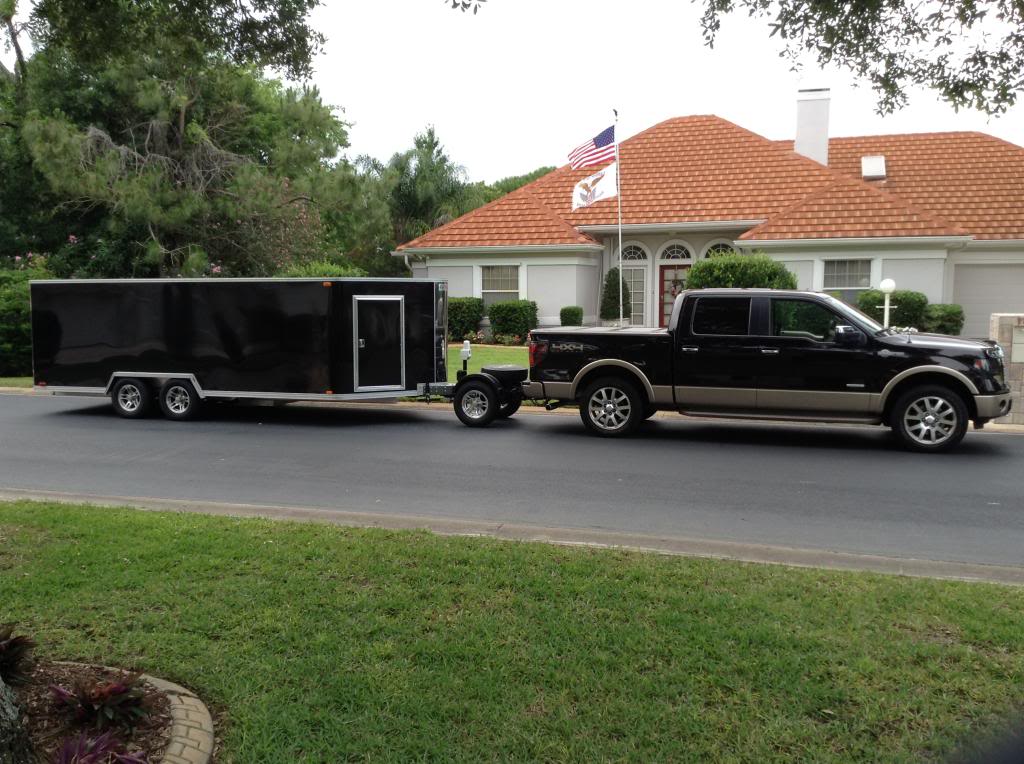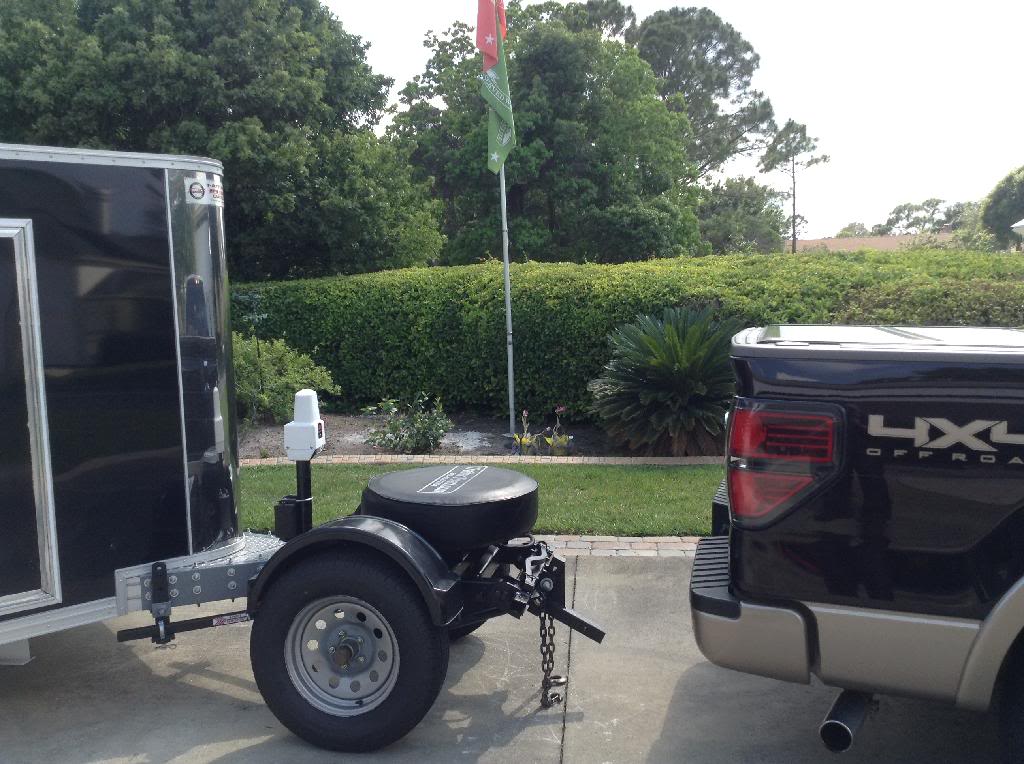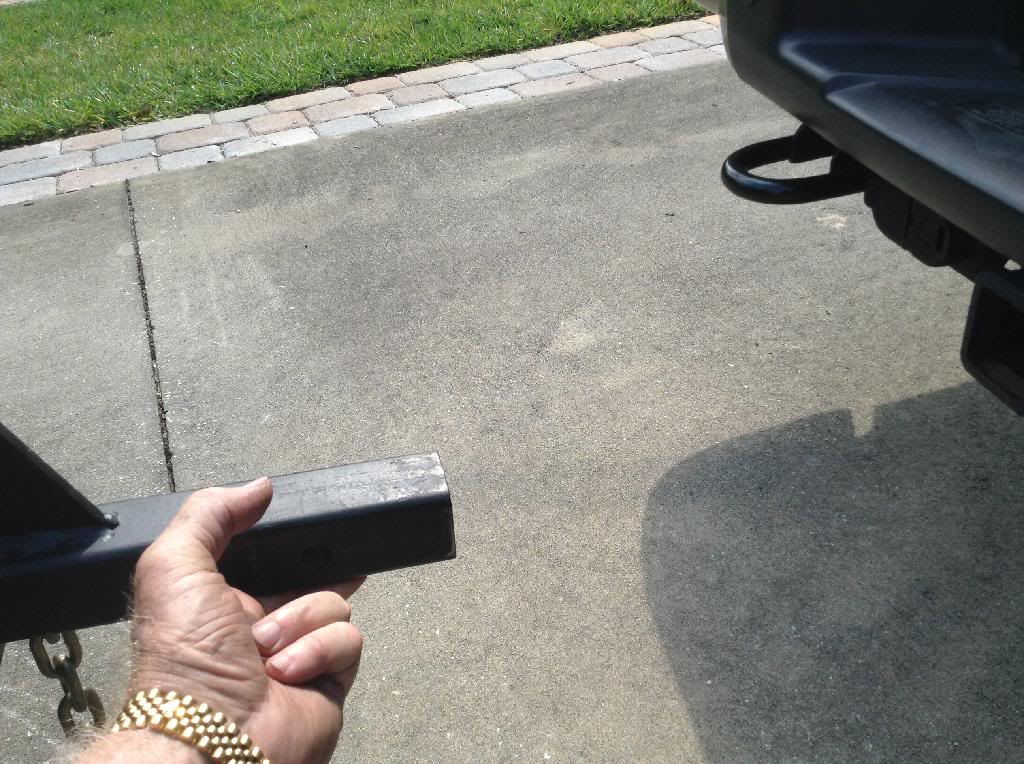Why 5k limit for non WDH bumper pull?
#1
Is the limit due to 500 hitch weight limit? If you are under GCWR , under payload and under axle ratings etc then why the limit. What difference to the truck and safety if the trailer rides fine without sway? An example of this would be a 20' flatbed weighing 3500# and a 6000# load positioned with the weight on the tandems. I've never seen one set up with a WDH yet.
#2
Senior Member
EDIT: Missed your title so didn't really answer your question.
Dunno what the answer is. Ford will not tell you for sure.
My guess is that the hitch receiver itself can handle more weight without a WDH; there are after market hitch receivers (especially for the superduties) that have the same weight rating for weight carrying and weight distributing. But Ford doesn't want you lifting too much weight off the front axle without a WDH so they lower the weight carrying number.
For a lot of guys hauling tractors, a WDH is just too much trouble, and they're not going too far, nor too fast ... hopefully. Some of them will slap on air bags or an extra spring if the truck "looks" too over-loaded, but that doesn't help with the loose steering or the overloaded rear axle. I did that many years ago and ended up with a blown rear axle bearing.
The same question applies to GVWR and rear GAWR. A lot of trucks are over-weight and everything seems to run fine. How long they will last depends upon how much they are over and how frequently and how far they are run.
My guess is that the hitch receiver itself can handle more weight without a WDH; there are after market hitch receivers (especially for the superduties) that have the same weight rating for weight carrying and weight distributing. But Ford doesn't want you lifting too much weight off the front axle without a WDH so they lower the weight carrying number.
For a lot of guys hauling tractors, a WDH is just too much trouble, and they're not going too far, nor too fast ... hopefully. Some of them will slap on air bags or an extra spring if the truck "looks" too over-loaded, but that doesn't help with the loose steering or the overloaded rear axle. I did that many years ago and ended up with a blown rear axle bearing.
The same question applies to GVWR and rear GAWR. A lot of trucks are over-weight and everything seems to run fine. How long they will last depends upon how much they are over and how frequently and how far they are run.
The following users liked this post:
A7B2FX4 (02-10-2015)
#3
Senior Member
I believe the 5k limit is due to the 500lb carrying and ford wanting you to have a certian level of tonge wt.
Less than 10% could lead to sway and too much dead tounge wt. will make the front rise and handle poorly.
ie. A 10000# hauler with 500# on the ball probably wont pull verry well so the 5k limit.
Conversly a 5000# travel trailer with 800# on the ball will also not handle well with out a wdh so the 500# limit.
Less than 10% could lead to sway and too much dead tounge wt. will make the front rise and handle poorly.
ie. A 10000# hauler with 500# on the ball probably wont pull verry well so the 5k limit.
Conversly a 5000# travel trailer with 800# on the ball will also not handle well with out a wdh so the 500# limit.
The following users liked this post:
A7B2FX4 (02-10-2015)
#4
Senior Member
Is the limit due to 500 hitch weight limit? If you are under GCWR , under payload and under axle ratings etc then why the limit. What difference to the truck and safety if the trailer rides fine without sway? An example of this would be a 20' flatbed weighing 3500# and a 6000# load positioned with the weight on the tandems. I've never seen one set up with a WDH yet.
I believe the 5k limit is due to the 500lb carrying and ford wanting you to have a certian level of tonge wt.
Less than 10% could lead to sway and too much dead tounge wt. will make the front rise and handle poorly.
ie. A 10000# hauler with 500# on the ball probably wont pull verry well so the 5k limit.
Conversly a 5000# travel trailer with 800# on the ball will also not handle well with out a wdh so the 500# limit.
Less than 10% could lead to sway and too much dead tounge wt. will make the front rise and handle poorly.
ie. A 10000# hauler with 500# on the ball probably wont pull verry well so the 5k limit.
Conversly a 5000# travel trailer with 800# on the ball will also not handle well with out a wdh so the 500# limit.
Your example of a 3500 lb. trailer and 6000 lb. load is 9500 lbs. total. You should have 10%-15% of the trailer weight on the tongue to prevent dangerous trailer sway. 10% minimum, 12%-13% is better. So you should have at least 950 lbs. on the tongue, and 1140 lbs. (12%) would be better. Of course, that 1140 lbs. will overload your 1050 lb. rated hitch. Even with 950 lbs. on the tongue, the front tires will be seriously unloaded. You may just keep going straight when you come to the turn or you may lock up the front brakes when trying to stop. The truck manufacturer is telling you that if you have 500 lbs. of load behind the rear axle, you need a WD hitch to put some weight back on the front tires.

#5
Thanks for the input! I recently started using 20' bumper pull flatbed for a 6000# skid steer. It tows like a dream without a WDH because the load can be positioned in just the right spot. Unlike a TT or enclosed cargo trailer sway is NOT a problem. So I was surprised to read the limitation of 5000# Ford put on the receiver.
A new product out there is the weigh safe hitch just for people like myself who find a WDH way too much trouble to use with constantly changing trailer loads. That product has a built in scale right in the hitch to give weight.
Lastly would the 5000# limitation also apply to something like the "toad" mentioned on this forum?
A new product out there is the weigh safe hitch just for people like myself who find a WDH way too much trouble to use with constantly changing trailer loads. That product has a built in scale right in the hitch to give weight.
Lastly would the 5000# limitation also apply to something like the "toad" mentioned on this forum?
#6
Senior Member
iTrader: (1)
As has been mentioned, greater than 500 lbs of tongue weight without a WDH will squat the rear, put too much weight on the rear axle, and lighten up the front axle too much.
The truck should be able to "pull" any load up to the published max trailer weight for the truck - as long as the rig doesn't exceed the GCWR.
With a WDH redistributing about 20% of the tongue weight forward to the front axle, as well as another 20% back to the trailer's axle/s, the hitch can handle up to 1050 lb tongue weight with the standard tow package, and the sticker for the max tow package says that's up to 1150 lbs.
The sticker for a standard tow package hitch says with a WDH you can pull up to a 10,500 lb trailer, and with the max tow up to an 11,500 lb trailer. The published "max trailer weight" for every version of the truck is less than those weights on the hitch, and those "max trailer weight" numbers are also not realistic at all - they can only be reached by a zero options/no frills/plain jane truck. Any truck with a few options will only be able to pull a trailer much lighter than those "sales brochure" numbers.
So...I think the hitch on any F150 can "pull" up to the limit published on the sticker on the hitch without ripping the hitch off the truck. However, in most cases the GVWR/payload capacity of the truck will limit the tongue weight, which of course will limit the max weight of the trailer to something much less than the published "max trailer weight".
Now....as for a Trailer Toad. My King Ranch only has the standard tow package, and it's a 4x4 with offroad pkg, and has a bunch of options. The published payload capacity is only 1115 lbs, and after adding my bed liner and BakFlip tonneau it's down to 1020 lbs!!!
 With me and the wife in the cab, along with her luggage and snack cooler, and a few tools in the bed, I only have around 500 lbs remaining for tongue weight before I'm at the GVWR limit. And my car hauler trailer is about 6500 lbs loaded, and has a bit more than 700 lb tongue weight.
With me and the wife in the cab, along with her luggage and snack cooler, and a few tools in the bed, I only have around 500 lbs remaining for tongue weight before I'm at the GVWR limit. And my car hauler trailer is about 6500 lbs loaded, and has a bit more than 700 lb tongue weight.That's why I got a Trailer Toad. The Toad carries the entire tongue weight, so all I have to be concerned about is keeping the rig under GCWR, and insure that the trailer doesn't exceed the published max loaded trailer weight of 9600 lbs (which is less than the hitch limit of 10,500 lbs).
My truck's GVWR is 7200 lbs, and now I can load it right up that if I want to, and still pull my trailer - because I don't need any capacity at all for tongue weight, because that's all supported by the Trailer Toad.
If I load me and the wife and her stuff in the cab, and put several hundred lbs of tools and track support stuff in the bed, I might bring the truck up to 7000 lbs. Normally that would leave 200 lbs for tongue weight, but I don't even have any concerns about tongue weight any more.
The GCWR of my truck is 15,500 lbs. Subtract the 7000 lb truck and that leaves me 8500 lbs that I can tow. The Trailer Toad weighs about 200 lbs (newer heavier duty ones might be 300 or a little more), so I can pull an 8300 lb trailer and be within limits of all ratings of the truck. An 8300 lb trailer would normally have a tongue weight of around 1000 lbs - something I couldn't even do with my truck completely empty before the Trailer Toad!!
Bottom line - your hitch should be able to "pull" a trailer up to 5000 lbs without a WDH, and up to 10,500 or 11,500 lbs with a WDH without ripping the hitch off your truck.
However, the vertical load limit (the weight of your WDH head and tongue weight of your trailer) can't exceed the payload capacity you have remaining after you load your truck up with people and stuff you'll have in it when towing.
With a Trailer Toad carrying the entire tongue weight, you can pull a trailer that won't exceed the GCWR limit of your truck.
Here's my truck sitting perfectly level because the 700 lb tongue weight (trailer is about 6500 lbs loaded) is carried entirely by the Trailer Toad:

You can see below that the entire tongue weight is on the Trailer Toad (the tongue jack is fully retracted), and shank is just hanging down:

And because there's no tongue weight at all on the shank, I'm able to easily lift it up in order to insert it into the receiver of the truck's hitch:

.
#7
Senior Member
I tried a WDH a couple of times with my open deck car hauler hauling my Jeep . I could not tell and difference other than it made me not want to tow anywhere because of all the trouble to hook up . That said it may work for someone who cannot control there hitch weight like you can hauling a movable vehicle .
I like the toad idea that is a neat setup that makes hooking up look easy but it also looks expensive . My F150 squats a little more than I prefer compared to my previous 2500 but I will cure that with Air Bags at some point. Also as the
OP said I have never seen a WDH on a equipment type trailer and I myself got a few strange looks in the parking lot of the ORP when I tried the WDH .
I like the toad idea that is a neat setup that makes hooking up look easy but it also looks expensive . My F150 squats a little more than I prefer compared to my previous 2500 but I will cure that with Air Bags at some point. Also as the
OP said I have never seen a WDH on a equipment type trailer and I myself got a few strange looks in the parking lot of the ORP when I tried the WDH .
Trending Topics
#8
I'd be careful. You need to have adequate tongue weight. What makes you think you are less subject to sway? That doesn't make any sense at all to me.
#9
Ford and all the others in their tow ratings leave a lot to be desired. I would gather the 5000# rating for bumper pull is based on the 10% hitch weight but it is just about universally ignored by flatbed owners. WDH hitches can be a big asset for single purpose flatbed owners who always tow the same weight but for those who see a variety of objects it is a totally impractical system to try and use.



